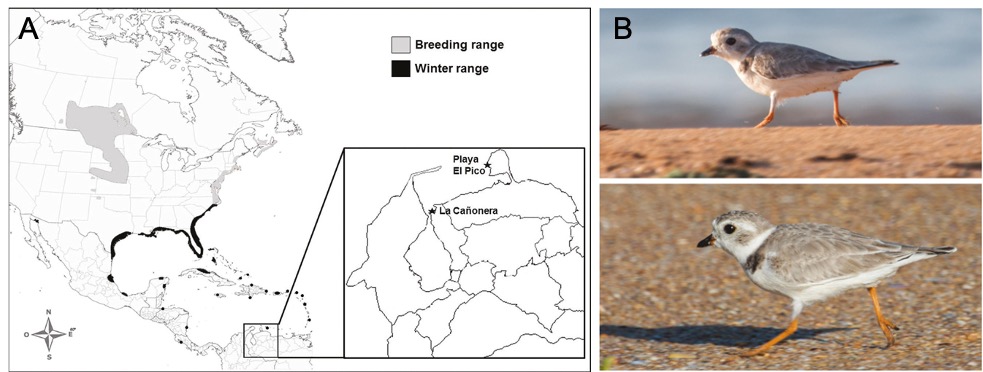With its position in the middle of the Americas, Venezuela provides an ideal stop-over for migratory shorebirds on their annual journeys between high northern latitudes and the tropics, or onward to the southern hemisphere. Thirty-five species use Venezuela’s wetlands, alongside a further 13 residents, and aerial and terrestrial shorebird surveys conducted since the 1980s confirm the regional importance of the country’s coasts and marshes.
Video credit: Carolina Dávila
We have been involved in shorebird work since 2005, when Sandra Giner, professor at the Institute of Zoology and Tropical Ecology (IZET-UCV) began a research project in the Cuare Ramsar Site. Efforts soon took off in several other regions, and since 2006, teams have effected systematic annual counts under the auspices of the Neotropical Waterbird Census. By 2016, funding from Environment Canada enabled the Western Hemisphere Shorebird Reserve Network (WHSRN), through its Executive Office at Manomet, to begin supporting the Venezuelan NGO Fudena. This enabled a census and capacity building programme that identifies priority sites for shorebird conservation, raises awareness of shorebirds among land managers and decision-makers, and trains professional and amateur ornithologists in shorebird census techniques. As a result, we have provisionally identified a score of national priority areas for conservation, thousands of shorebirds have been counted at dozens of major sites in western Venezuela as part of the International Shorebird Survey, and a couple of hundred local people have participated in WHSRN activities. With growing interest and expertise, many more people—from enthusiastic amateurs to dedicated park guards—are photographing shorebirds, sharing field experiences on social media and uploading sightings to eBird.
Video credit: Carolina Dávila
One early conservation success was the designation of Venezuela’s first WHSRN reserve, Salina Solar Los Olivitos. This site is exploited for salt production by the company Produsal, but its value was soon recognised by local conservationists such as Lermith Torres whose organisation Grupo MANGLE works with the commercial operators to ensure that the site is managed to preserve its attraction for shorebirds. Lermith also runs environmental education activities and festivals for locals, including the indigenous Wayuu people. Peak counts of over 100,000 small peeps have been made at this site in recent years, with more than half a million individuals estimated a decade ago. The main users are Western Calidris mauri and Semipalmated Sandpipers C. pusilla, with a range of scarcer species, amongst them Venezuela’s first Red-necked Phalaropes Phalaropus lobatus, whose extraordinary North Atlantic–Pacific Ocean migration route has recently been revealed. Another species reported for the first time is Piping Plover Charadrius melodus, subject of the current paper.
Video credit: Jhonathan Miranda
The Piping Plover is a small shorebird of international conservation concern whose population has declined significantly since the 1950s. It is one of the most highly threatened shorebirds in the United States and Canada, federally listed in both countries and assessed as globally Near Threatened. Its non-breeding distribution outside the USA has only recently been elucidated: it favours the Gulf of Mexico coast south to the Yucatán Peninsula, and the Bahamas to northern Cuba. We compile available records (Figure 1) to reveal a wider winter range. Our recent sightings from Venezuela show that the species straggles to northern South America (Figure 1).

Figure 1: A) Distribution of Piping Plover Charadrius melodus: grey shading denotes breeding range, black areas indicate winter range and recent records, and stars indicate record localities for Venezuela. B) Non-breeding Piping Plover Charadrius melodus, Playa El Pico, western Paraguaná Peninsula, Falcón, Venezuela, February 2018 (Jhonathan Miranda)
Together with new records of other shorebirds, seabirds and migratory passerines (vireos and parulid warblers), our findings show that coastal north-western Venezuela is of much greater conservation importance than previously appreciated. Indeed, the shorebird censuses of 2019 and 2020 (with additional support from the Bobolink Foundation and WaderQuest) reveal significant wintering or passage populations of species with worrying population trends such as Hudsonian Whimbrel Numenius phaeopus hudsonicus and Red Knot Calidris canutus. Juvenile birds figure prominently amongst the visitors and, to judge by data emerging from geolocator and satellite tagging, this mosaic of mangroves, beaches and mudflats looks likely to be a major, more northerly over-wintering region for youngsters during their first year of life. The visitors face a range of threats ranging from chronic oil pollution to illegal clearance of their vital mangrove habitat, and construction of dykes that effect tidal regimes (even within national parks) to new powerlines. At the same time, there are opportunities to work with industries such as the shrimp farms that are expanding rapidly through this area to avoid construction that would reduce shorebird habitat and to encourage management that provides shorebird feeding opportunities. Thanks to the growing interest in these remarkable birds, we may be in time to mitigate some of these threats, and to identify and protect the most important sites for shorebirds. Indeed, as a result of censuses in 2018 and 2019, two further WHSRN reserves at Punta Maragüey and Punta Caimán, have already been identified, both unfortunately affected by oil. There is a pressing need to increase research on the state of shorebird populations on the coasts of Venezuela, and to encourage the bodies officially responsible for the environment to take the actions necessary to control and manage threats such as ongoing oil pollution.

Author Information
Sandra B. Giner F.
Instituto de Zoología y Ecología Tropical, Universidad Central de Venezuela
Christopher J. Sharpe
Consultant, Manomet / Western Hemisphere Shorebird Reserve Network
Research Associate, Colección Ornitológica Phelps
